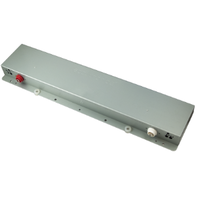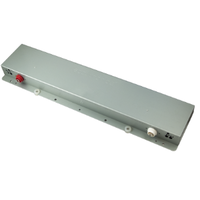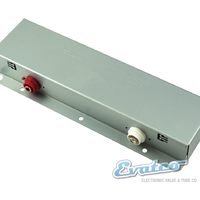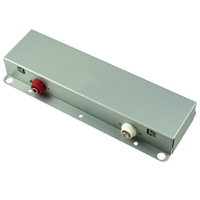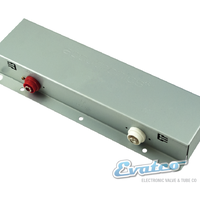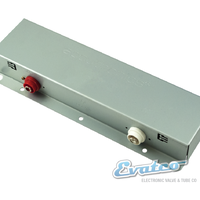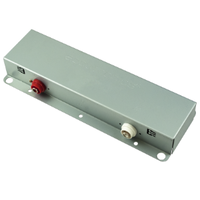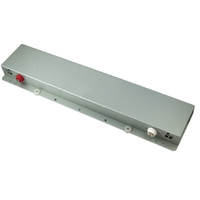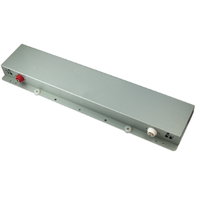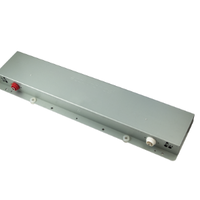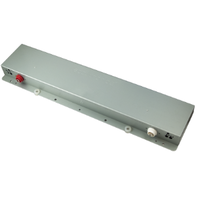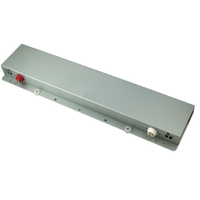Accutronics have been famous for years for their reverb tanks, providing OEM solutions for some of the best amplifier brands in the world. In addition, they have a large range of replacement tanks for a wide range of amplifiers.
For more information on Reverb tanks please read the following however for more detailed information click into the
reverb menu and each model provides a list of amps that it will work with each tank (plus more)
There are a number of different types of reverb tanks available. Use this guide to help you determine part number based upon your specifications and application.
Type 4
The industry standard for years, the type 4 is still manufactured today using Hammond's original design. Four counter-wound and coupled springs deliver superior mechanical performance and the classic sound that helped make the Fender Twin Reverb amp famous. Outer channel dimensions are 16.75" length x 4.735" width x 1.313" height.
Type 8
Designed for applications in which the overall sound quality is important and a compact package is required. Small in size, this three-spring reverb approaches the rich textural quiality of the larger reverb units. Outer channel dimensions are 9.25" length x 3.375" width x 1.313" height.
Type 9
Six springs, counter-wound, coupled and placed in parallel, combine to create Sound Enhancement's fullest, richest reverb effect throughout the full range of musical sound. Ideally suited for keyboard, sound reinforcement and pedal steel applications. Outer channel dimensions are 16.75" length x 4.375" width x 1.313" height.
Part Numbering System
Reverb tank part numbers consist of a seven digit code, ie 4EB2C1B. Each digit in the part number represents a specification. The meanings of these digits are as follows:
| Digit |
Specification |
| 1st |
Reverb Type |
| 2nd |
Input Impedance |
| 3rd |
Output Impedance |
| 4th |
Decay |
| 5th |
Connectors |
| 6th |
Locking Devices |
| 7th |
Mounting Plane |
Part Numbering Specifications
| Value |
Type 1 or Type 4 |
Type 8 or Type 9 |
| Digit #1 - Reverb Type |
| 1 |
Type 1 |
|
| 4 |
Type 4 |
|
| 8 |
|
Type 8 |
| 9 |
|
Type 9 |
| Digit #2 - Input Impedance |
| A |
8 Ohms |
10 Ohms |
| B |
150 Ohms |
190 Ohms |
| C |
200 Ohms |
240 Ohms |
| D |
250 Ohms |
310 Ohms |
| E |
600 Ohms |
800 Ohms |
| F |
1,475 Ohms |
1,925 Ohms |
| Digit #3 - Output Impedance |
| A |
500 Ohms |
600 Ohms |
| B |
2,250 Ohms |
2,575 Ohms |
| C |
10,000 Ohms |
12,000 Ohms |
| Digit #4 - Decay Time |
| 1 |
Short (1.2 to 2.0s) |
| 2 |
Medium (1.75 to 3.0s) |
| 3 |
Long (2.75 to 4.0s) |
| Digit #5 - Connectors |
| A |
Input Grounded/Output Grounded |
| B |
Input Grounded/Output Insulated |
| C |
Input Insulated/Output Grounded |
| D |
Input Insulated/Output Insulated |
| E |
No Outer Channel |
| Digit #6 - Locking Devices |
| 1 |
No Lock |
| Digit #7 - Mounting Plane |
| A |
Horizontal, Open Side Up |
| B |
Horizontal, Open Side Down |
| C |
Vertical, Connectors Up |
| D |
Vertical, Connectors Down |
| E |
On End, Input Up |
| F |
On End, Output Up |
Example: 4EB2C1B
Consulting the table below, we can see that a 4EB2C1B can be broken down in the following way:
- Digit #1 = 4, meaning this is a Type 4 tank
- Digit #2 = E, meaning the input impedance for this tank is 600 Ohms
- Digit #3 = B, meaning the output impedance for this tank is 2,250 Ohms
- Digit #4 = 2, meaning the decay time for this tank is Medium
- Digit #5 = C, meaning the connectors on this tank are Input Insulated / Output Grounded
- Digit #6 = 1, meaning there is no locking device
- Digit #7 = B, meaning the mounting plane is Horizontal, open side down
Example:
8EB2C1B
Consulting the table above, we can see that an 8EB2C1B can be broken down in the following way:
- Digit #1 = 8, meaning this is a Type 8 tank
- Digit #2 = E, meaning the input impedance for this tank is 800 Ohms
- Digit #3 = B, meaning the output impedance for this tank is 2,575 Ohms
- Digit #4 = 2, meaning the decay time for this tank is Medium
- Digit #5 = C, meaning the connectors on this tank are Input Insulated / Output Grounded
- Digit #6 = 1, meaning there is no locking device
- Digit #7 = B, meaning the mounting plane is Horizontal, open side down
There are a number of different types of reverb tanks available. Use this guide to help you determine part number based upon your specifications and application.
Type 4
The industry standard for years, the type 4 is still manufactured today using Hammond's original design. Four counter-wound and coupled springs deliver superior mechanical performance and the classic sound that helped make the Fender Twin Reverb amp famous. Outer channel dimensions are 16.75" length x 4.735" width x 1.313" height.
Type 8
Designed for applications in which the overall sound quality is important and a compact package is required. Small in size, this three-spring reverb approaches the rich textural quiality of the larger reverb units. Outer channel dimensions are 9.25" length x 3.375" width x 1.313" height.
Type 9
Six springs, counter-wound, coupled and placed in parallel, combine to create Sound Enchancement's fullest, richest reverb effect throughout the full range of musical sound. Ideally suited for keyboard, sound reinforcement and pedal steel applications. Outer channel dimensions are 16.75" length x 4.375" width x 1.313" height.
Part Numbering System
Reverb tank part numbers consist of a seven digit code, ie 4EB2C1B. Each digit in the part number represents a specification. The meanings of these digits are as follows:
| Digit |
Specification |
| 1st |
Reverb Type |
| 2nd |
Input Impedance |
| 3rd |
Output Impedance |
| 4th |
Decay |
| 5th |
Connectors |
| 6th |
Locking Devices |
| 7th |
Mounting Plane |
Part Numbering Specifications
| Value |
Type 1 or Type 4 |
Type 8 or Type 9 |
| Digit #1 - Reverb Type |
| 1 |
Type 1 |
|
| 4 |
Type 4 |
|
| 8 |
|
Type 8 |
| 9 |
|
Type 9 |
| Digit #2 - Input Impedance |
| A |
8 Ohms |
10 Ohms |
| B |
150 Ohms |
190 Ohms |
| C |
200 Ohms |
240 Ohms |
| D |
250 Ohms |
310 Ohms |
| E |
600 Ohms |
800 Ohms |
| F |
1,475 Ohms |
1,925 Ohms |
| Digit #3 - Output Impedance |
| A |
500 Ohms |
600 Ohms |
| B |
2,250 Ohms |
2,575 Ohms |
| C |
10,000 Ohms |
12,000 Ohms |
| Digit #4 - Decay Time |
| 1 |
Short (1.2 to 2.0s) |
| 2 |
Medium (1.75 to 3.0s) |
| 3 |
Long (2.75 to 4.0s) |
| Digit #5 - Connectors |
| A |
Input Grounded/Output Grounded |
| B |
Input Grounded/Output Insulated |
| C |
Input Insulated/Output Grounded |
| D |
Input Insulated/Output Insulated |
| E |
No Outer Channel |
| Digit #6 - Locking Devices |
| 1 |
No Lock |
| Digit #7 - Mounting Plane |
| A |
Horizontal, Open Side Up |
| B |
Horizontal, Open Side Down |
| C |
Vertical, Connectors Up |
| D |
Vertical, Connectors Down |
| E |
On End, Input Up |
| F |
On End, Output Up |
Example: 4EB2C1B
Consulting the table below, we can see that a 4EB2C1B can be broken down in the following way:
- Digit #1 = 4, meaning this is a Type 4 tank
- Digit #2 = E, meaning the input impedance for this tank is 600 Ohms
- Digit #3 = B, meaning the output impedance for this tank is 2,250 Ohms
- Digit #4 = 2, meaning the decay time for this tank is Medium
- Digit #5 = C, meaning the connectors on this tank are Input Insulated / Output Grounded
- Digit #6 = 1, meaning there is no locking device
- Digit #7 = B, meaning the mounting plane is Horizontal, open side down
Example:
8EB2C1B
Consulting the table above, we can see that an 8EB2C1B can be broken down in the following way:
- Digit #1 = 8, meaning this is a Type 8 tank
- Digit #2 = E, meaning the input impedance for this tank is 800 Ohms
- Digit #3 = B, meaning the output impedance for this tank is 2,575 Ohms
- Digit #4 = 2, meaning the decay time for this tank is Medium
- Digit #5 = C, meaning the connectors on this tank are Input Insulated / Output Grounded
- Digit #6 = 1, meaning there is no locking device
- Digit #7 = B, meaning the mounting plane is Horizontal, open side down
Information sourced from amplified parts

